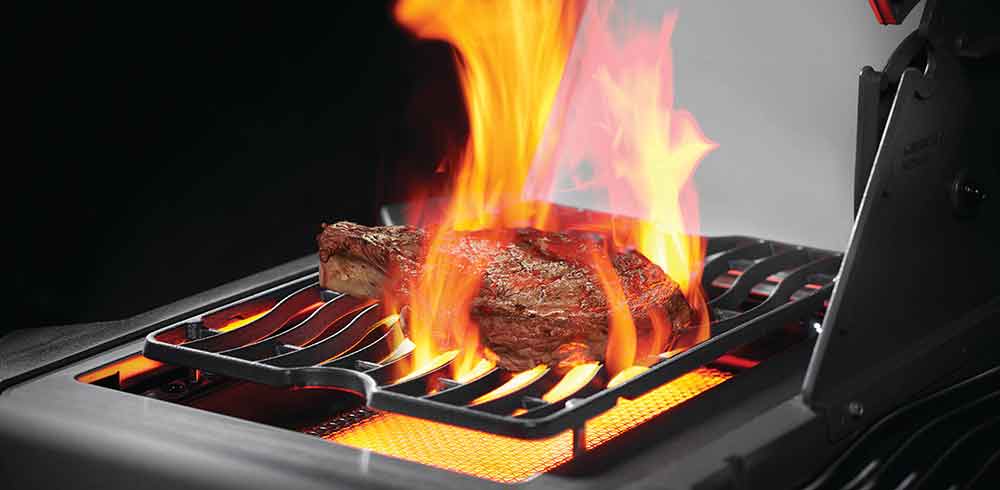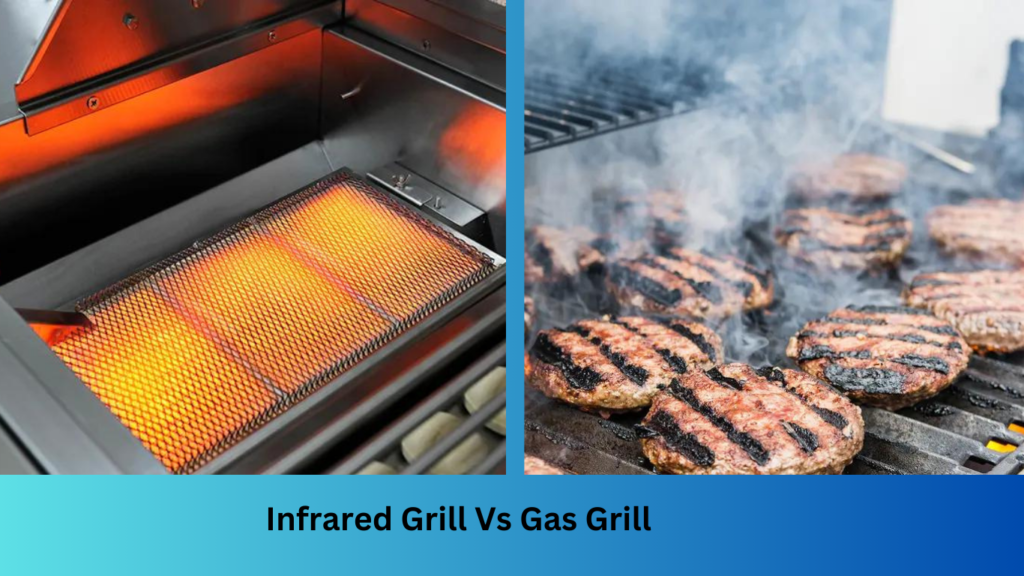Infrared Grill vs Gas Grill – Which is best? Let’s dive into the sizzling debate of outdoor cooking options! 🔥 Grilling season is here, and you want to make sure you have the right grill for those mouthwatering barbecues. But with so many choices out there, it can be tough to decide between an infrared grill and a gas grill. So, what’s the difference? Which one cooks meat to perfection, gives you that delicious smoky flavor, and is easy to use? Grab your spatula and let’s find out in this ultimate showdown between infrared grills and gas grills!💪🍖
When it comes to choosing between an infrared grill and a gas grill, it’s essential to consider the features that matter most to you.
Here are five key factors to help guide your decision:
-
Heat distribution: Infrared grills provide even heat distribution, resulting in juicier and more flavorful food.
-
Temperature control: Gas grills offer precise temperature control, allowing you to adjust the heat easily.
-
Cooking speed: Infrared grills heat up quickly, reducing cooking time compared to gas grills.
-
Versatility: Gas grills offer more cooking options with additional features like side burners and rotisseries.
-
Maintenance: Infrared grills are easier to clean due to their design, while gas grills may require more upkeep.

Key Takeaways: Infrared Grill vs Gas Grill – Which is Best?
– Both infrared grills and gas grills have their pros and cons. – Infrared grills use radiant heat for faster and more even cooking. – Gas grills are versatile, allowing for easy temperature control and different cooking methods. – Infrared grills are great for searing meat and achieving that perfect steakhouse crust. – Gas grills offer a wider range of cooking options, including indirect grilling and smoking.
Comparing Infrared Grill vs Gas Grill – Which is Best?

When it comes to outdoor cooking, having a reliable grill is essential. Two popular options on the market are infrared grills and gas grills. Both offer unique features and benefits and deciding on which one to choose is difficult. In this article, we will compare the infrared grill and the gas grill, exploring their key features, user experience, pros and cons, price points, and more. By the end, you’ll have a better understanding of which grill is best suited for your needs.
Overview of Infrared Grill:
Infrared grills have revolutionized outdoor cooking with their advanced heating technology. Instead of using direct heat from an open flame or hot surface, infrared grills use infrared radiation to cook the food. This technology allows for faster and more even cooking, as the heat is distributed evenly across the cooking surface.
Infrared grills typically use a ceramic or metal plate that radiates heat directly onto the food. This eliminates flare-ups and reduces the risk of charring or burning. Infrared grills also retain the natural juices and flavors of the food, resulting in succulent and delicious meals.
Another advantage of infrared grills is their ability to reach high temperatures in a short amount of time. This makes them ideal for searing steaks and other meats, locking in flavor and creating a perfect crust. Infrared grills are also known for their fuel efficiency, as they require less gas or electricity compared to traditional grills.
Overview of Gas Grill:
Gas grills have been a popular choice for outdoor cooking for many years. They offer convenience, versatility, and precise temperature control. Gas grills utilize propane or natural gas to create an open flame that cooks the food. They are equipped with burners that generate heat, which is then distributed evenly across the cooking grates.
One of the main advantages of gas grills is their ease of use. With the simple turn of a knob, you can ignite the grill and have it ready for cooking in no time. Gas grills also provide consistent temperature control, allowing you to adjust the heat to achieve the perfect level of doneness. This makes them suitable for a variety of cooking techniques, from grilling and roasting to baking and smoking.
Gas grills are also favored for their large cooking surfaces, making them ideal for cooking for a crowd. Many gas grills come with additional features like side burners, rotisserie kits, and warming racks, providing added functionality and versatility. Additionally, gas grills are relatively easy to clean and maintain compared to other types of grills.
Key Features Compared:
Now that we have a general understanding of both infrared grills and gas grills, let’s compare their key features in detail.
Cooking Technology:
Infrared Grill: Infrared grills use advanced infrared heating technology to cook food. The heat is evenly distributed across the cooking surface, resulting in faster and more even cooking. The direct infrared heat also helps retain the natural juices and flavors of the food, creating delicious and succulent meals.
Gas Grill: Gas grills rely on an open flame created by burning propane or natural gas. The heat generated by the burners is distributed evenly across the cooking grates, allowing for precise temperature control. Gas grills are versatile and can be used for a variety of cooking techniques.
Temperature Control:
Infrared Grill: Infrared grills typically offer limited temperature control options. While they excel at high-temperature cooking for searing and grilling, they may not be as suitable for low and slow-cooking methods. Some infrared grills may have adjustable burner controls for more temperature control.
Gas Grill: Gas grills provide precise temperature control, allowing you to adjust the heat to your desired level. They often have multiple burners that can be independently controlled, providing flexibility for different cooking zones and techniques.
Cooking Surface:
Infrared Grill: Infrared grills usually have a smaller cooking surface compared to gas grills. This makes them more suitable for smaller gatherings or individuals who have limited outdoor space.
Gas Grill: Gas grills come in a variety of sizes, ranging from compact models to large ones with multiple burners. They offer ample cooking space, making them ideal for hosting parties and cooking for a crowd.
Versatility:
Infrared Grill: Infrared grills are well-suited for high-temperature cooking, such as searing steaks and burgers. However, their versatility for other cooking techniques may be limited.
Gas Grill: Gas grills are highly versatile and can be used for various cooking techniques, including grilling, roasting, baking, and smoking. They offer a wide temperature range, allowing you to cook a diverse range of dishes.
Fuel Source:
Infrared Grill: Infrared grills can be powered by either propane or electricity. Propane-powered infrared grills offer the advantage of portability, while electric models may require a dedicated power source.
Gas Grill: Gas grills are powered by propane or natural gas. Propane tanks can be easily replaced or refilled, while natural gas grills require a fixed gas line connection. Both options provide convenience and reliability.
Cleaning and Maintenance:
Infrared Grill: Infrared grills are relatively easy to clean, as they usually have fewer components and no direct exposure to open flames. The infrared plates can be quickly wiped clean with a brush or cloth.
Gas Grill: Gas grills require regular cleaning to ensure optimal performance and to prevent the buildup of grease and residue. Cleaning gas grills typically involves removing and cleaning the grates, burners, and other parts.
Price Range:
Infrared Grill: Infrared grills are generally more expensive than gas grills due to their advanced heating technology. Prices can range from a few hundred dollars to several thousand dollars.
Gas Grill: Gas grills are available in a wide price range, from budget-friendly options to high-end models. The cost of gas grills depends on factors such as size, features, and brand reputation, but they are generally more affordable than infrared grills.
User Experience:
The user experience is an important factor to consider when choosing between an infrared grill and a gas grill. Here, we will take a closer look at the overall experience users can expect from each type of grill.
Infrared Grill:
Using an infrared grill provides a unique cooking experience. The advanced heating technology allows for faster cooking times, saving you precious time when preparing meals. Infrared grills also produce less smoke compared to traditional grills, making them ideal for those who live in areas with strict smoke regulations or limited outdoor space.
The even heat distribution of infrared grills ensures that your food is cooked consistently, reducing the risk of overcooking or undercooking. The direct infrared heat also results in food that is juicy and flavorful. However, it’s important to note that the limited temperature control of infrared grills may require some adjustment in cooking techniques.
Overall, infrared grills provide a convenient and efficient grilling experience, particularly for those who prioritize quick and even cooking.
Gas Grill:
Gas grills have been a popular choice among grill enthusiasts for their versatility and ease of use. The ability to control the heat precisely allows for precise cooking and greater control over the final result. Whether you’re grilling steaks, roasting a whole chicken, or smoking ribs, a gas grill offers the flexibility to accommodate various cooking techniques.
Another aspect of the user experience with gas grills is the convenience they offer. Igniting the grill is as simple as turning a knob, and the temperature can be adjusted quickly and easily. Gas grills also tend to have larger cooking surfaces, allowing you to cook for a larger group of people.
Cleaning and maintaining a gas grill is relatively straightforward, ensuring that you can spend more time enjoying your grilled creations and less time on maintenance tasks.
Pros and Cons:
Infrared Grill:
Pros:
-
Cook food faster and more evenly
-
Retain natural juices and flavors
-
Fuel efficient
Cons:
-
Limited temperature control options
-
Smaller cooking surface
-
Higher price point
Gas Grill:
Pros:
-
Precise temperature control
-
Large cooking surface
-
Versatile cooking options
Cons:
-
May require more maintenance
-
Produces more smoke
-
Less fuel efficient in some cases
Comparison Table:
Feature Infrared Grill Gas Grill Cooking Technology Uses advanced infrared heating technology Relies on an open flame created by burning propane or natural gas Temperature Control May offer limited options Provides precise control with adjustable burners Cooking Surface Smaller cooking surface Larger cooking surface Versatility Well-suited for high-temperature cooking Highly versatile with a wide range of cooking techniques Fuel Source Propane or electricity Propane or natural gas Cleaning and Maintenance Relatively easy to clean Requires regular cleaning and maintenance Price Range Generally more expensive Wide range of price options
Which is Better – Infrared Grill vs Gas Grill – Which is Best?
Now that we have explored the key features, user experience, pros and cons, and price points of infrared grills and gas grills, it’s time to make a decision on which is the best option for you.
The choice between an infrared grill and a gas grill ultimately depends on your personal preferences, cooking style, and budget. If you prioritize faster and more even cooking, as well as retaining the natural flavors of your food, an infrared grill may be the better choice for you. However, if you value precise temperature control, versatility, and a wider range of price options, a gas grill may be the more suitable option.
Ultimately, the best grill for you will depend on your specific needs and preferences. It’s recommended to visit a local retailer or browse online to see the different models in person and make an informed decision. You can also consider consulting with grill enthusiasts or professionals who can provide valuable insights based on their expertise.
Three reasons why the final winner is the {product1}:
-
Faster and more even cooking
-
Retains natural juices and flavors
-
Fuel efficient
Keep in mind that regardless of which grill you choose, both infrared grills and gas grills offer a unique and enjoyable outdoor cooking experience. Happy grilling!
Frequently Asked Questions
What are the main differences between an infrared grill and a gas grill?
An infrared grill uses infrared technology to cook food, while a gas grill uses propane or natural gas. The main difference between the two lies in the heat source. Infrared grills use high-intensity infrared burners that directly heat the food, resulting in quicker and more even cooking. On the other hand, gas grills use traditional burners that heat the air inside the grill, which then cooks the food indirectly.
Another key difference is temperature control. Infrared grills can reach very high temperatures quickly, making them ideal for searing and achieving that perfect char on steaks or burgers. Gas grills, while still capable of reaching high temperatures, may require more time to heat up. Gas grills also provide more temperature control options since you can adjust the burners individually for different cooking zones.
Which type of grill is better for cooking juicy and tender meats?
Infrared grills are known for their ability to cook juicy and tender meats. The intense heat emitted by the infrared burners quickly sears the meat’s surface, sealing in the juices and creating a flavorful caramelized crust. The high temperatures also help to reduce cooking time, preventing the meat from drying out. However, it’s important to note that proper cooking techniques and meat selection also play a significant role in achieving juicy and tender results.
Gas grills, while not as quick to sear, can also produce juicy and tender meats with the right techniques. By utilizing indirect heat and lower temperatures, you can achieve slow and gentle cooking, allowing the meats to retain their moisture. Additionally, using marinade brines, or basting can further enhance the juiciness and tenderness of the meats when using a gas grill.
Which type of grill is more suitable for outdoor use?
Both infrared grills and gas grills are suitable for outdoor use, but gas grills may have a slight advantage. Gas grills are more common and widely available, making it easier to find a suitable model for your outdoor cooking needs. Propane tanks or natural gas connections are readily accessible, and gas grills usually offer larger cooking surfaces, making them ideal for outdoor gatherings and cooking for a larger number of people.
Infrared grills, on the other hand, are also suitable for outdoor use, but they are not as common as gas grills. They may require a bit more effort to find and set up. However, if you value the quick and intense heat provided by an infrared grill and enjoy the unique cooking experience it offers, it can still be a great choice for outdoor cooking.
Which type of grill is more energy-efficient?
Infrared grills are generally more energy-efficient than gas grills. This is because infrared grills use less fuel to produce the same amount of heat due to the direct infrared radiation. The intense heat generated by the infrared burners allows for rapid and efficient cooking, requiring less cooking time and less energy consumption overall. Additionally, infrared grills often have better heat retention, reducing heat loss and further optimizing energy efficiency.
Gas grills, while not as energy-efficient as infrared grills, still offer decent energy performance. The gas burners in these grills provide consistent heat and can be regulated based on the desired temperature, allowing for efficient cooking. Energy consumption can be further optimized by utilizing the grill’s lid to retain heat and minimize heat loss. Regular maintenance and cleaning of the grill can also help improve its energy efficiency.
Which type of grill is easier to clean and maintain?
Generally, gas grills are easier to clean and maintain compared to infrared grills. Gas grills have a traditional design with burners and cooking grates that can be easily removed for cleaning. They also often have a drip tray or grease management system that collects drippings and makes cleanup relatively straightforward. Many gas grills also come with porcelain-coated grates that are easier to clean and prevent food from sticking.
Infrared grills, on the other hand, can be a bit more challenging to clean. The intense heat emitted by the infrared burners can cause food juices and grease to quickly carbonize, leading to stubborn stains and residue on the cooking surfaces. Cleaning an infrared grill often requires specialized tools and techniques to remove the carbonized debris. However, some manufacturers offer infrared grills with removable grates or trays that make cleaning easier.
Infrared Grill vs Gas Grill: What To Choose In 2023?
Summary
So, what did we learn in this article about infrared grills vs gas grills? Let’s recap! Infrared grills use special heat waves to cook food quickly and evenly, while gas grills use flames from propane or natural gas. Both grills have their pros and cons. Infrared grills are great for searing juicy steaks and burgers, but gas grills give you more control over the temperature. Infrared grills are also easier to clean because they have fewer parts to worry about, but gas grills are more versatile and allow you to cook a wider variety of foods. If you like the convenience of a fast cooking time and easy clean-up, the infrared grill might be for you.
But if you prefer having more control and flexibility in your grilling, the gas grill could be the right choice. Remember, it’s important to consider factors like your cooking preferences, budget, and available space when deciding which grill is best for you. So, next time you need a grill, think about whether an infrared grill or a gas grill would suit your needs. Happy grilling!




